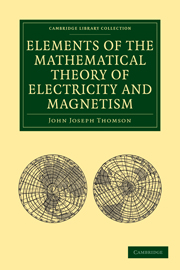Book contents
- Frontmatter
- PREFACE TO FIRST EDITION
- PREFACE TO THE SECOND EDITION
- PREFACE TO THE THIRD EDITION
- PREFACE TO THE FOURTH EDITION
- Contents
- CHAP. I General Principles of Electrostatics
- CHAP. II Lines of Force
- CHAP. III Capacity of Conductors. Condensers
- CHAP. IV Specific Inductive Capacity
- CHAP. V Electrical Images and Inversion
- CHAP. VI Magnetism
- CHAP. VII Terrestrial Magnetism
- CHAP. VIII Magnetic Induction
- CHAP. IX Electric Currents
- CHAP. X Magnetic Force due to Currents
- CHAP. XI Electromagnetic Induction
- CHAP. XII Electrical Units: Dimensions of Electrical Quantities
- CHAP. XIII Dielectric Currents and the Electromagnetic Theory of Light
- CHAP. XIV Thermoelectric Currents
- CHAP. XV The Properties of Moving Electric Charges
- INDEX
CHAP. XIII - Dielectric Currents and the Electromagnetic Theory of Light
Published online by Cambridge University Press: 07 September 2010
- Frontmatter
- PREFACE TO FIRST EDITION
- PREFACE TO THE SECOND EDITION
- PREFACE TO THE THIRD EDITION
- PREFACE TO THE FOURTH EDITION
- Contents
- CHAP. I General Principles of Electrostatics
- CHAP. II Lines of Force
- CHAP. III Capacity of Conductors. Condensers
- CHAP. IV Specific Inductive Capacity
- CHAP. V Electrical Images and Inversion
- CHAP. VI Magnetism
- CHAP. VII Terrestrial Magnetism
- CHAP. VIII Magnetic Induction
- CHAP. IX Electric Currents
- CHAP. X Magnetic Force due to Currents
- CHAP. XI Electromagnetic Induction
- CHAP. XII Electrical Units: Dimensions of Electrical Quantities
- CHAP. XIII Dielectric Currents and the Electromagnetic Theory of Light
- CHAP. XIV Thermoelectric Currents
- CHAP. XV The Properties of Moving Electric Charges
- INDEX
Summary
264. The Motion of Faraday Tubes. Dielectric Currents. In Chapter xi. we considered the relation between the currents in the primary and secondary circuits when an alternating current passes through the primary circuit, we did not however discuss the phenomena occurring in the dielectric between the circuits. As we regard the dielectric as the seat of the energy due to the distribution of the currents, the study of the effects in the dielectric is of primary importance. We owe to Maxwell a theory, now in its main features universally accepted, by which we are able to completely determine the electrical conditions, not merely in the conductors but also in every part of the field. We shall also see that Maxwell's views lead to a comprehensive theory of optical as well as of electrical phenomena, and enable us by means of electrical principles to explain the fundamental laws of Optics.
Before specifying in detail the principles of Maxwell's theory, we shall endeavour to show by the consideration of some simple cases that in considering the relation between the work done in taking unit magnetic pole round a closed circuit and the current flowing through that circuit (see Art. 203), we must include under the term current, effects other than the passage of electricity through conducting media, if we are to retain the conception that the dielectric is the seat of the energy in electric and magnetic phenomena.
- Type
- Chapter
- Information
- Elements of the Mathematical Theory of Electricity and Magnetism , pp. 480 - 505Publisher: Cambridge University PressPrint publication year: 2009First published in: 1895



